初高中衔接讲义:英语的词性
- 格式:docx
- 大小:44.39 KB
- 文档页数:3


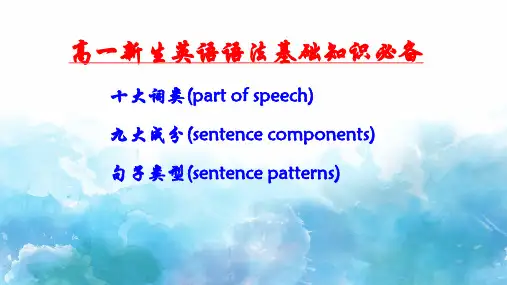

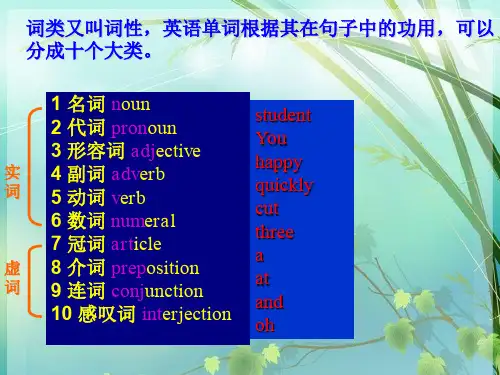
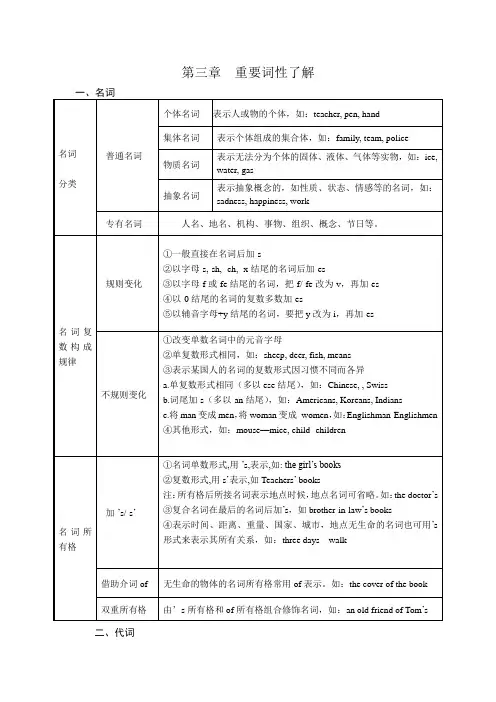
第三章重要词性了解二、代词Exercises:1. Here is the that his younger brother loves best.A. coffee cupB. coffee’s cupC. cup of coffeeD. coffee of cup2. Mr. Tony always has to tell his students at the beginning of his lectures.A. some good pieces of newsB. some pieces of good newsC. some good piece of newsD. some piece of good news3. As a businessman, Mr. Li gained his by selling famous of English and American writers.A. wealth; workB. wealth; worksC. wealths ; worksD. wealths ; work4. He is a kind-hearted man. People can get on well with him.A. FewB. A littleC. Quite a fewD. Little5. The post office isn’t far from here. It’s only bicycle ride.A. half an hours’B. an hour and a halfC. half an hourD. half an hour’s6. The population of Shanghai very big and most of its population native people.A. are ; isB. is ; isC. are; areD. is; are7. —Would you like to have ,Tom?—No, thanks, l have had enough.A. any more orange and applesB. some more oranges and applesC. any more oranges and applesD. some more oranges and apple8. —Which do you prefer to drink, or coffee?—, please.A. teas; Two teaB. tea; Two teaC. tea; Two teasD. teas; Two teas9. lt was really to get a present from him on her birthday party that she couldn’t believe it, looking at him in .A. such big surprise; a surpriseB. such a big surprise; surpriseC. so big surprise; a surpriseD. such big surprise; surprise10. These are bikes. The twin brothers like them very much.A. Jack’s and Jerry’sB. Jack’s and JerryC. Jack’s and Jerry B. Jack and Jerry’s11. —How much water is there in the bottle?—.You’d better come to fetch another bottle.A. A littleB. NothingC. No oneD. None12. Bill works harder than in his class. He is the most excellent student l have met.A. the other boysB. other boysC. any boyD. another boy三、形容词二、比较级1、只能修饰形容词原级的词very, quite, so, too. 例如:He is too tired to walk on. 他太累了以至不能再继续走了。
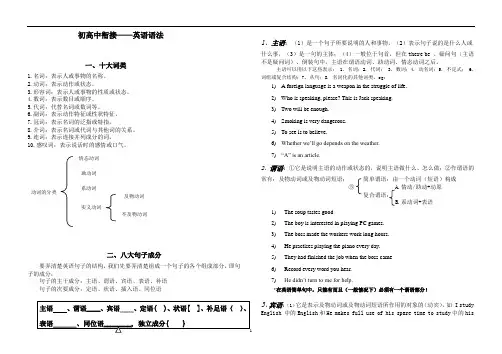
初高中衔接——英语语法一、十大词类1.名词:表示人或事物的名称。
2.动词:表示动作或状态。
3.形容词:表示人或事物的性质或状态。
4.数词:表示数目或顺序。
5.代词:代替名词或数词等。
6.副词:表示动作特征或性状特征。
7.冠词:表示名词的泛指或特指。
8.介词:表示名词或代词与其他词的关系。
9.连词:表示连接并列成分的词。
10.感叹词:表示说话时的感情或口气。
二、八大句子成分要弄清楚英语句子的结构,我们先要弄清楚组成一个句子的各个组成部分,即句子的成分:句子的主干成分:主语、谓语、宾语、表语、补语 句子的次要成分:定语、状语、插入语、同位语1、主语:(1)是一个句子所要说明的人和事物,(2)表示句子说的是什么人或什么事,(3)是一句的主体;(4)一般位于句首,但在there be 、疑问句(主语不是疑问词)、倒装句中,主语在谓语动词、助动词、情态动词之后。
主语可以用以下这些表示: 1. 名词;2. 代词; 3. 数词;4. 动名词;5. 不定式; 6. 词组或复合结构;7. 从句;8. 名词化的其他词类。
eg:1) A foreign language is a weapon in the struggle of life. 2) Who is speaking, please? This is Jack speaking. 3) Two will be enough.4) Smoking is very dangerous. 5) To see is to believe.6) Whether we’ll go depends on the weather. 7) “A” is an article.2、谓语:①它是说明主语的动作或状态的,说明主语做什么、怎么做;②作谓语的常有:及物动词或及物动词短语; 简单谓语:由一个动词(短语)构成 ③ A.情动/助动+动原 复合谓语:B.系动词+表语1) The soup tastes good 2) The boy is interested in playing PC games. 3) The boss made the workers work long hours.4) He practises playing the piano every day. 5) They had finished the job when the boss came 6) Record every word you hear. 7) He didn’t turn to me for help.*在英语简单句中,只能有而且(一般情况下)必须有一个谓语部分!3、宾语:(1)它是表示及物动词或及物动词短语所作用的对象的(动宾),如 I studyEnglish 中的English 和He makes full use of his spare time to study 中的his动词的分类情态动词 助动词 系动词实义动词及物动词不及物动词spare time.(2)介词后的名词或代词,叫做介词的宾语(介宾),如He went away with no words中的no words. (3)一般位于及物动词或介词之后。

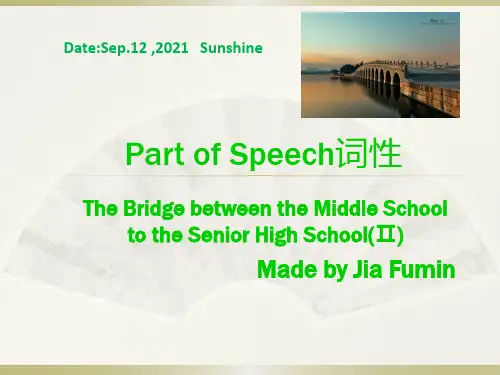
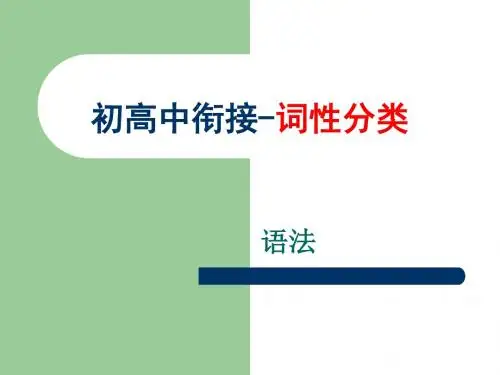

初高中英语衔接讲义英语的词性一、名词(n.)1.定义:表示人或事物名称的词叫名词。
e.g. Tom, scientist, doctor, feeling, Internet, Shanghai, animal2.名词的句法功能二、代词(pron.)1.定义:代词是代替名词的词。
英语的代词按照其不同的含义与作用可分为9类:人称代词,物主代词,反身代词,指示代词,相互代词,不定代词,疑问代词,连接代词,关系代词。
2.分类单数复数1)人称代词主格:I, you, he, she, it we, you, they宾格:me, you, him, her, it us, you, them2)物主代词形容词:my, your, his, her, its our, your, their 名词:mine, your, his, hers, its ours, yours, theirs3)反身代词 myself, yourself, himself, herself, ourselves, yourselves, themselvesitself4)指示代词 this, that these, those5)相互代词宾格: each other, one another所有格:each other’s, one another’s6)不定代词可数:each, one, many, (a) few, both, another, either, neither不可数:much, (a) little可数/不可数:all, some, none, such, any, other复合不定代词:anybody, anyone, anything, somebody, someone, something, nobody, nothing, everybody, everyone, everything7)疑问代词:who, whom, whose, which, what8)连接代词:who(ever), whom(ever), whose(ever), which(ever), what(ever)9)关系代词:who, whom, whose, which, that, as三、形容词(adj.)1.定义:形容词用于修饰名词或代词,表示人或事物的性质和特征,在句中可作:定语、表语、补语或状语。
初高中知识衔接第一讲:词性快乐暑假,轻松超越在英语中,名词是表达人、事物、地点、抽象概念等的基本词汇。
其用法相当丰富,包括作为主语、宾语、定语等,同时还需要注意可数名词与不可数名词的区别以及名词的所有格形式。
以下是一些关于英语名词用法的相关试题:一、名词的基本用法1. 选择合适的名词填空:- The _______ (cat/cats) are playing in the garden.- I like to eat _______ (apple/apples) for breakfast.答案:- The cats are playing in the garden. (此处需要用复数形式,因为有多只猫)- I like to eat apples for breakfast. (此处需要用复数形式,因为苹果是可数名词)二、可数名词与不可数名词2. 判断下列名词是可数名词还是不可数名词:- advice- water- book- happiness答案:- advice 是不可数名词,表示建议。
- water 是不可数名词,表示水。
- book 是可数名词,表示书籍。
- happiness 是不可数名词,表示幸福。
三、名词的所有格形式3. 将下列句子中的名词转化为所有格形式:- The boy's bag is on the table. (the boy)- The teachers' room is on the second floor. (the teachers)答案:- The boy's bag is on the table. (单数名词词尾加"'s")- The teachers' room is on the second floor. (复数名词词尾有s,后面加撇。
没有s,要加"'s")四、名词作定语4. 名词作定语,表示类别。
初高中衔接讲义:英语的词性
一、名词(n.)
1.定义:表示人或事物名称的词叫名词。
e.g. Tom, scientist, doctor, feeling, Internet, Shanghai, animal
2.名词的句法功能
二、代词(pron.)
1.定义:代词是代替名词的词。
英语的代词按照其不同的含义与作用可分为9类:人称代词,物主代词,反身代词,指示代词,相互代词,不定代词,疑问代词,连接代词,关系代词。
2.分类
单数复数
1)人称代词主格:I, you, he, she, it we, you, they
宾格:me, you, him, her, it us, you, them
2)物主代词形容词:my, your, his, her, its our, your, their
名词:mine, your, his, hers, its ours, yours, theirs
3)反身代词 myself, yourself, himself, herself, ourselves, yourselves, themselves
itself
4)指示代词 this, that these, those
5)相互代词宾格: each other, one another
所有格:each other’s, one another’s
6)不定代词可数:each, one, many, (a) few, both, another, either, neither
不可数:much, (a) little
可数/不可数:all, some, none, such, any, other
复合不定代词:anybody, anyone, anything, somebody, someone, something, nobody, nothing, everybody, everyone, everything
7)疑问代词:who, whom, whose, which, what
8)连接代词:who(ever), whom(ever), whose(ever), which(ever), what(ever)
9)关系代词:who, whom, whose, which, that, as
三、形容词(adj.)
1.定义:形容词用于修饰名词或代词,表示人或事物的性质和特征,在句中可作:定语、表语、补语或状语。
2.句法功能
四、副词(adv.)
1.定义:副词用于修饰动词、形容词、副词、介词短语、句子,主要用作状语,少数与介词同形的副词还可作表语或补足语。
注:副词有9种:时间,地点,方式,程度,疑问,连接,关系,频度和说明性副词。
2.句法功能
五、冠词(art.)
1.定义:虚词,本身不能独立使用,一般出现在名词前,对名词加以限制。
冠词分为不定冠词(a, an)和定冠词(the)两种。
定冠词the表特指,e.g. the man; 不定冠词a(n)在名词前表泛指,e.g. a man。
六、介词(prep)
1.定义:介词又叫前置词,表示它后面的名词或相当于名词的其他结构与句子其他成分的关系。
n./pron./doing/宾语从句等→宾语一般是名词或与其功能相似的词或结构。
2.句法功能
1) The conference will be held on May 4th, in Beijing.
2) The building at the end of the street is a hotel.
3) The question is under discussion.
4) We found the map quite out of date.
5) To my surprise, they succeeded.
七、连词(conj.)
1.定义:连词是在词、短语、从句或句子之间起连接作用的词,是虚词,不单独作句子成分,按其在句子中的作用可分为并列连词和从属连词两种。
1)并列连词表词、短语、句子彼此之间具有并列关系, e.g. and, but, both…and, or, so等。
2)从属连词表连接主句和从句的连词。
e.g. I don’t know whether he will go himsel
f.
八、动词(v.)
1.定义:指表动作的词,还表状态和性质的词,有时态、语态和语气等的变化。
2.功能:放在主语后充当谓语,称为谓语动词,充当其他句子成分时称为非谓语动词,此时有形式上的变化:doing, to do, done。
3.分类:1)根据在句中的功能,可分为:①实意动词(行为动词)②系动词③助动词④情态动词
2)根据其后是否可直接跟宾语,可分为①及物动词(vt.)②不及物动词(vi.),有时同一个动词既可用作vt.,也可用作vi.。
3)从是否延续来分,可分为①延续性动词②非延续性动词(短暂性动词)
注:1)vt.不可单独使用,必须和其后的宾语一起使用,有被动语态。
vi.后不能直接跟宾语,若跟宾语,必须借助于介词或其他词类;也可单独使用,无被动。
2)系动词本身有词义,但不能单独作谓语,后须跟表语构成系表结构,说明主语的状况、性质、特征等情况。
3)助动词协助主动词构成谓语动词词组的词叫助动词。
它本身无词义,不可单独作谓语。
基本动词有:be/do/have。
4)情态动词有词义,但不能单独作谓语,必须和实意动词一起构成谓语。
青苔动词没有人称、数的变化,两个纯情态动词不能连用,但可以说:I’ll have to…
九、数词numeral (num.)
表示数目或顺序one, two…first, second…
十、感叹词,Interjections (int.)
oh, hello, hi, yeah等。